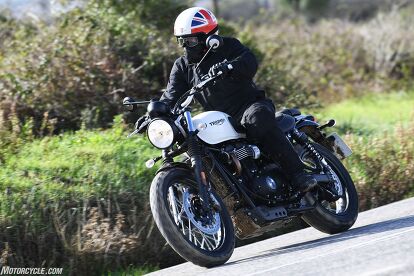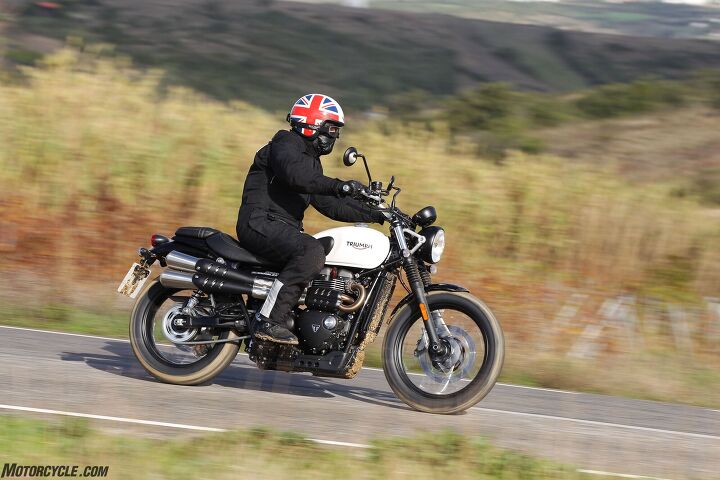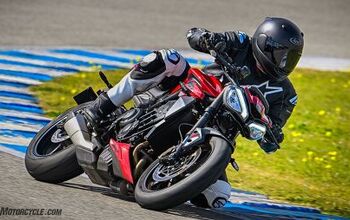2019 Triumph Street Twin / Street Scrambler Review – First Ride
Say hello to the Twins
The main difference between the 2016 Street Twin and 2017 Street Scrambler, and the new 2019 versions of each, is that my Aerostich Roadcrafter suit is much snugger when riding the new ones. On the first day we rode the new bikes from Cascais, Portugal, down the road to Lisbon in the rain. Semi-lost and wandering along, I was all set to conclude I couldn’t tell much difference between new and old. On Day Two, the rain had stopped, the roads were drying, and our Official Triumph Guide became a Brit called Nick Plumb, former Paris-Dakar regular.
That morning Nick gave us a nice little pep talk, warning about the damp, slick cobblestones, etc., and encouraging us to embrace the relaxed, casual nature of the new Street Twin and Street Scrambler, and how lovely it was going to be to take in the sights of rural Portugal rather than race through them. That lasted a while, and it was lovely, but there’s something in guys like Nick that requires them to go slightly quicker than whatever is in their mirrors, if only briefly, to make a point.
There is indeed plenty of sightseeing in the quaint little Portuguese towns scattered around the hilly green countryside. But they’re interconnected by ancient stretches of twisting two-lane, and the pattern became that every time we hit a section of that, it seemed to fall to me to be the thing in Nick’s mirrors. It’s Nick’s job, of course, to show us journalists what the bikes are capable of, and for being “casual” or “retro” or “classic,” we already knew both these bikes can lift their skirts and go even before Triumph gave them a big horsepower injection.
Soon enough, the Portuguese GP was on (Estoril was somewhere in the area) as we wrung the necks of the little Triumphs. They liked it. With all that Paris-Dakar experience, it often looked like Nick would be just as happy off the pavement on his Scrambler as on it, but that never quite happened.
In some shady spots a little dampness lingered long into the afternoon, so a bit of caution was advised. But not much. Torquey little machines like these, with their upright ergonomics, are near-perfect tools for unwinding country backroads, and though 65 horsepower isn’t a lot, it is a lot more than before, and it usually feels like plenty as you roll the throttle to the stop at every exit, with 270-degree crankshaft sounds blatting from the tailpipes, working the new brakes and front fork hard.
After we’d wound our way through the second or third excellent section of those fast curves, we pulled over at a junction to wait for the rest of the group, with the molten sides of our bootsoles smoldering.
“These work well at that kind of sedate pace,” I observed.
“Yes,” says Nick, “I think I’m warmed up enough to switch out of Rain Mode now.”
MO heaped tons of praise on both of these bikes when they first appeared, they’ve been big successes for Triumph, and so why wouldn’t they go ahead and stoke the fire with tasty new upgrades?
Power
Biggest change would be the addition of quite a bit of horsepower – Triumph puts it at 18%, and the bike now makes a claimed 65 hp instead of the previous 54 at 5900 rpm.
Still not a lot, but still plenty for real-world fun– and Triumph’s claimed numbers for this bike are usually really close to what our dyno says: The 54-horse claim for the previous engine wound up being 52.6 rear-wheel hp, and the butt dyno thinks the new engine will be close to 65. As I was riding it, I was thinking, this feels almost as strong as a Yamaha MT-07 or Suzuki SV650 on top…
… as well it should, given the Triumph’s big displacement advantage over those bikes. As a result of that displacement, the torque’s the thing. Claimed torque is up to 59 foot-pounds, also a bit higher in the rev range at 3800 rpm. And that’s a bunch more than an MT-07 or SV. In the real world, the Speed Twin should be more than a match for those “modern” bikes.
The new bike doesn’t have the instant off-idle response the previous one did, but 99.9% of riders will agree that the delayed gratification is way worth the big overall boost just slightly later in the powerband.
A bit more compression, now up to 11:1, a revised camshaft, lighter crankshaft and balance shafts, all work together to come up with the newfound power, which now happens 500 rpm higher, at 7500 rpm.
Powerbands, really, since Speeds Scrambler and Twin share the same engine. Some of us felt the Twin was a little quicker than the Scrambler: Does the tight turn the Scrambler’s exhaust headers make reduce its power a smidge? I think we’re imagining things.
Anyway, whether you’re just tooling around town or attacking the countryside, fuel delivery is impeccable, power delivery is linear, five-speed gearboxes are perfectly fine, and the slip-assist clutch works well and has a very light lever pull.
Suspension
The next thing you won’t notice at first is the addition of a new KYB 41mm cartridge fork up front where the old 41mm damper-rod one was before. You won’t notice it around town, because the new fork isn’t really any better at absorbing bumps and things at slower speeds. But when you start taking advantage of the new engine’s ability to hustle the bike along at an 18%-faster clip while struggling to stay in Nick’s draft, you’ll then appreciate how much better control the fork has of the entire program at elevated speeds, hard on the brakes, in big g-outs, etc. The harder you ride, the more the new fork shows its superiority.
Wheel travel remains 4.7 inches (120mm) front and rear, for both Street Twin and Scrambler, though the Scrambler’s shocks are slightly longer: 120mm isn’t much for a “Scrambler,” but hey it’s a Street Scrambler and it keeps the seat height down to 31.1 inches. The Twin’s seat is 29.9 in.
Brakes
Speaking of hard on the brakes, both bikes get a new four-piston Brembo caliper up front clamping the single 310mm disc. The old set-up was perfectly adequate; the new one is excellent, with great power and linear feel, and now your brake says BREMBO on it. All about the branding these days.
So what’s the difference?
If you’re taller you’ll love the Scrambler’s extra legroom and two-inch wider, taller handlebar. The cockpit is roomier and there’s that little bit more leverage over the front wheel when you’re off-road. Thanks to its 19-inch wire-spoked front wheel raising the front end compared to the Street Twin’s 18-in. front, the Scrambler’s got 0.5-degree more rake and about 7mm more trail (25.1 and 102mm for Twin, 25.6 and 109mm for Scrambler).
The Street Twin’s more compact and aero at higher speeds, but its seat is 10mm higher this year thanks to a restuffing with new foam compounds. Very nice. Both bikes are ergonomically correct and all-day rideable. For lots of freeway and high-speed riding, the Street Twin is the winner. For backroads and exploring, most of us like the Scrambler.
The Street Twin should win the Portuguese Backroad GP, but it seems like it was easier to keep up with Nick’s Scrambler on another Scrambler, and it seems like it was down to the tires. We had no complaints re: the special Pirelli Phantoms Triumph specced for the Street the first time we rode it in 2016 (a bias-ply front and radial rear), but this time, on Portuguese pavement, the Phantoms didn’t have as much grip as the Metzeler Tourances Triumph puts on the Scrambler. Even though the Scrambler’s a smidge taller, the Tourance’s extra traction had it leaning into corners more eagerly and dragging peg more confidently than the Street. The Street was hanging in there, but only by licking nearer the edge of the traction envelope.
New Electronics
The Street Twin has Road and Rain modes, and Road apparently doesn’t do much good in the Rain, judging from the guy in our group who spun up the rear in the wet and crashed exiting a roundabout on day one. The mode buttons change engine mapping and traction control settings, but this is pre-IMU traction control, which is better than nothing.
To Road and Rain, the Street Scrambler adds an Off Road mode, which disables ABS and TC. Most of the time you can change modes on the fly, but you can only select Off Road when you’re stopped. Are you sure you want to do this, Dave?
Style
Naturally Triumph bumped up the style points on its new best-selling Classic. New instruments – a single round dial per bike – sport new looks including a “metallic embellisher” and a new dial face with “translucent silver-faced chaplets;” there’s also now a digital tachometer in there. (In spite of the lack of a real tachometer, I don’t think I ran into the 7500-rpm rev limiter even once.)
The Scrambler gets a new “leather and textile-inspired” seat material, new numberplate-looking sidepanels and cool new graphics and logo. Also you might notice the 41mm fork tubes are farther apart. Is that a style or a performance thing? It’s both.
Your Street Twin gets very cool new cast wheels with machined highlights, updated badging, logos and instrument also, an LED taillight…
Both bikes have a USB port under the seat, and there are something like 140 accessories standing by in the Triumph catalog for both bikes, accessorizing being a key ingredient in modern moto profitability.
Portugal was a great place to ride, and unexplored territory to me. Just up the coast from us, in Nazarene, is what’s supposed to be the biggest surfing wave in the world. It’s been there forever, our taxi driver told us, but only a big deal recently because the Americans discovered it. Well, don’t get too snippy, buddy, because America was already there when Christopher Columbus sailed from a port around the corner from Lisbon in 1492 and made such a big deal of it.
For Triumph and its Street Twin and Street Scrambler, what’s old is also new again, and the virtues of these bikes’ simplicity and ease of use are being rediscovered by a whole new generation of riders, including lots of first-timers and women. Deservedly so. Not only are they both surprisingly sporty, they’re also both excellent, economical (once past the purchase price anyway) do-everything motorcycles.
2019 Triumph Street Twin / Street Scrambler
+ Highs
- 18% more power you can feel and great mpg
- Even more comfortable than before
- Triumph can’t make a bike that doesn’t love to be flogged
– Sighs
- How hard could it be to lose the tank seams?
- $11k for the base Scrambler is getting up there
- There’s not enough to not like
In Gear

Helmet: Davida Jet £31900
Suit: AerostichRoadcrafter 3 $1,197
Boots: SidiCanyon $315
Gloves: Dainese 4-Stroke Evo $219.95
2019 Triumph Street Scrambler
| Engine | 17.5/20 |
| Suspension/Handling | 13.5/15 |
| Transmission/Clutch | 8.5/10 |
| Brakes | 9.5/10 |
| Instruments/Controls | 4.5/5 |
| Ergonomics/Comfort | 9.25/10 |
| Appearance/Quality | 9.0/10 |
| Desirability | 8.25/10 |
| Value | 7.5/10 |
| Overall Score | 87.5/100 |
2019 Triumph Street Twin
| Engine | 17.5/20 |
| Suspension/Handling | 13.5/15 |
| Transmission/Clutch | 8.5/10 |
| Brakes | 9.0/10 |
| Instruments/Controls | 4.5/5 |
| Ergonomics/Comfort | 9.25/10 |
| Appearance/Quality | 9.0/10 |
| Desirability | 8.25/10 |
| Value | 8.0/10 |
| Overall Score | 87.5/100 |
Specifications | 2019 Triumph Street Twin | 2019 Triumph Street Scrambler |
|---|---|---|
| Engine Type | Liquid cooled, 8 valve, SOHC, 270° crank angle parallel Twin | |
| Displacement | 900cc | |
| Bore/Stroke | 84.6 x 80 mm | |
| Compression Ratio | 11:1 | |
| Maximum Power | 65 HP @ 7500 rpm (claimed) | |
| Maximum Torque | 59.0 lb-ft @ 3800 rpm (claimed) | |
| Fuel system | Multipoint sequential electronic fuel injection | |
| Exhaust | Brushed 2 into 2 exhaust system with twin brushed silencers | |
| Final drive | Chain | |
| Clutch | Wet, multi-plate assist clutch | |
| Gearbox | 5-speed | |
| Frame | Tubular steel cradle | |
| Swingarm | Twin-sided, tubular steel | |
| Front Wheel | Cast aluminum alloy multi-spoke 18 x 2.75in | Spoked Steel Rims. 19 x 2.5in |
| Rear Wheel | Cast aluminum alloy multi-spoke 17 x 4.25in | Spoked Steel Rims. 17 x 4.25in |
| Front Tire | 100/90-18 | 100/90-19 Metzeler Tourance |
| Rear Tire | 150/70 R17 | 150/70 R17 Metzeler Tourance |
| Front Suspension | Kayaba 41mm cartridge fork, 4.7 inches travel | |
| Rear Suspension | Kayaba twin shocks with adjustable preload, 4.7 inches rear wheel travel | |
| Front Brake | Single 310mm disc, Brembo 4-piston caliper, ABS | |
| Rear Brake | Single 255mm disc, Nissin 2-piston floating caliper, ABS | |
| Length | 82.3 inches | 85.7 inches |
| Width (Handlebars) | 30.9 inches | 32.7 inches |
| Height Without Mirrors | 43.9 inches | 44.1 inches |
| Seat Height | 29.9 inches | 31.2 inches |
| Wheelbase | 55.7 inches | 56.9 in inches |
| Rake | 25.1° | 25.6° |
| Trail | 4.0 inches | 4.3 inches |
| Dry Weight (claimed) | 436.5 lbs | 448 lbs |
| Fuel Tank Capacity | 3.2 gallons | |
| Fuel consumption | Combined 63.3 mpg (claimed) | Combined 61.9 mpg (claimed) |
More by John Burns




















































































Comments
Join the conversation
I can't help being a pedant: "the Scrambler’s got 0.5-degree more rake and about 7mm more trail (25.1 and 102mm for Twin, 25.6 and 109mm for Scrambler)" Actually, the Scrambler has less rake, but I will never tire of Burnsie's writing. :)
Ahh yes, the damn tank seams. I'm in the same boat as you J.B..